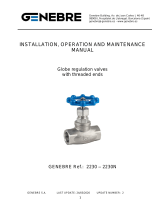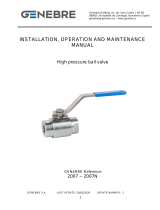Page is loading ...

Genebre Building. Av. de Joan Carles I, 46-48
08908 L'Hospitalet de Llobregat. Barcelona
(Spain)
genebre@genebre.es - www.genebre.es
GENEBRE S.A.
LAST UPDATE: 09/06/2021 UPDATE NUMBER: 3
1
INSTALLATION, OPERATION AND MAINTENANCE
MANUAL
Disk check valve, wafer type
GENEBRE Reference: 2415

Genebre Building. Av. de Joan Carles I, 46-48
08908 L'Hospitalet de Llobregat. Barcelona
(Spain)
genebre@genebre.es - www.genebre.es
GENEBRE S.A.
LAST UPDATE: 09/06/2021 UPDATE NUMBER: 3
2
Installation, operation and maintenance instructions
1. Breakdown drawing. ............................................................................................................ 3
1.1) List of valve components .............................................................................................. 3
2. Storage ................................................................................................................................ 3
3. Installation instructions ........................................................................................................ 4
3.1) Preparation ................................................................................................................... 4
3.2) Assembling ................................................................................................................... 4
4. Operation instructions .......................................................................................................... 5
4.1) Usage ........................................................................................................................... 5
4.2) Operation ...................................................................................................................... 6
5. Maintenance operations ...................................................................................................... 6
6. Reparation instructions ........................................................................................................ 6
6.1) Disassembling............................................................................................................... 6
6.2) Reassembling ............................................................................................................... 7
7. Opening pressure ............................................................................................................... 7
8. Hygiene and Safety Instructions: ......................................................................................... 7

Genebre Building. Av. de Joan Carles I, 46-48
08908 L'Hospitalet de Llobregat. Barcelona
(Spain)
genebre@genebre.es - www.genebre.es
GENEBRE S.A.
LAST UPDATE: 09/06/2021 UPDATE NUMBER: 3
3
1) Breakdown drawing.
1.1) List of valve components
Nº
Name
Material
Surface Treatment
Spare Part Code
1
Body
Stainless Steel 1.4408
Shot blasting
------
2
Disk
Stainless Steel 1.4408
Polishing
------
3*
Spring
Stainless Steel AISI 316
------
K2415
4
Spring Support
Stainless Steel AISI 316
------
------
5
Centering Ring
Stainless Steel
------
------
* Available spare parts
2) Storage
In case valve is not immediately installed, it is recommended to keep it inside the included
protective wrapping to avoid damages or dirt accumulation. The wrap must not be removed
until valve is to be installed. As much as possible, valves must be stored in a dry and clean
environment.

Genebre Building. Av. de Joan Carles I, 46-48
08908 L'Hospitalet de Llobregat. Barcelona
(Spain)
genebre@genebre.es - www.genebre.es
GENEBRE S.A.
LAST UPDATE: 09/06/2021 UPDATE NUMBER: 3
4
3) Installation instructions
3.1) Preparation
Remove any material remains of the valve wrapping.
Serious problems may arise with the installation of a valve in a dirty pipe.
Make sure the pipe is not dirty and doesn’t have welding particles, for example, before
installing it. This may cause irreparable damages in the valve when the equipment is started
→ prepare a clean working area.
Plan beforehand enough space for future maintenance operations.
Have available some flat gaskets to keep tightness between valve and pipe flanges.
Check correct performance of the valve by pushing the disk (part.2) in the direction of the
flow and making sure it goes back to the original position once it is released. If this is not the
case, check if there are foreign particles inside the valve and repeat the whole operation. If
the disk does not slide smoothly, valve must not be installed.
In case of vibrations in the pipe it is strongly recommended to mount anti-vibration elements
to absorb them. Otherwise, the life of the product could be drastically reduced.
3.2) Assembling
Disc check valves can be installed in any position, but the flow direction of the valve marked
by an arrow on the body must be taken into account.
ASCENDANT HORIZONTAL DESCENDANT BENDED
ATTENTION: in case you need to install the without spring, it can only be placed in vertical
position (ascendant fluid).
IMPORTANT:
- Wafer disk check valves by Genebre, S.A. are designed to be assembled between
flanges PN10, PN16, PN25, PN40, ANSI 150 and ANSI 300.

Genebre Building. Av. de Joan Carles I, 46-48
08908 L'Hospitalet de Llobregat. Barcelona
(Spain)
genebre@genebre.es - www.genebre.es
GENEBRE S.A.
LAST UPDATE: 09/06/2021 UPDATE NUMBER: 3
5
- take extreme care in centering the valve with respect to the axis of the pipe in order
to guarantee the tightness between body and flange. The valve has a centering
ring (part.5) which facilitates this operation, once the valve is installed this ring can
be removed.
- Do not weld once the valve is already assembled as it could be damaged due to
overheating and deformation of the sealing area.
- Verify good parallelism of the flanges. Leave enough space between them so that
valve can be easily inserted or removed.
- Tighten the flange screws until they make firm contact with the valve’s body. Apply
the alternate tightening method to assure a correct installation.
- Valve must never be assembled adjacent to an elbow, reducer, valve or pump in
order to avoid turbulences. Minimum distance recommended between these elements
is 10 times pipe's diameter -upstream- and 3 times pipe's diameter -downstream-
according to CR 13932:2000 standard.
- Please, refer to the product datasheet.
4) Operational instructions
4.1) Usage
Check valves are usually used to prevent fluid from coming back into the system. These are
Wafer valves, to be installed between flanges, and they provide a leakproof lock when used
adjusted to the pressure and temperature values for which they have been designed.
Body material for the valve, seat and rest of components has to be fully compatible with the
fluid circulating through the pipe. Otherwise, valve could be seriously damaged.

Genebre Building. Av. de Joan Carles I, 46-48
08908 L'Hospitalet de Llobregat. Barcelona
(Spain)
genebre@genebre.es - www.genebre.es
GENEBRE S.A.
LAST UPDATE: 09/06/2021 UPDATE NUMBER: 3
6
4.2) Operation
By default, this kind of valve does not need to be operated. Opening and closing are
automated, depending on pressure and direction of the flow. For more information about the
minimum opening pressure of the valve, please check the technical data sheet of the
product.
5) Maintenance operations
Check valves with metal sealing are designed so that they do not need any lubrication and/or
periodical maintenance during their life cycle.
However, periodical checks explained below will be useful to extend the service life of the
valve and reduce installation problems:
- Keep the valve in a completely closed position.
- Verify all threads, locks, fasteners and threaded ends to check if they are loose or rusted.
Tighten them if necessary.
- Inspect the valve and surrounding areas to verify if there is any leakage.
6) Reparation instructions
In case the fluid continues to circulate through the line once the valve is completely closed,
the leakage may be caused by damages on the sealing surface or an excessive erosion of
the spring material after many operational cycles. In both cases it will be necessary to
disassemble the valve for repairing it. GENEBRE, S.A. has replacement springs (part. 3).
However, it may be the case that (for example, in an area difficult to access), due to
economic reasons, it is not recommended to repair the valve but directly replace it.
6.1) Disassembling
You must remove the valve from the installation to repair it.
Make sure the line is cold, drained and depressurized.
Prepare a clean working area and adequate tools to perform mechanical tasks.
a - Loosen and extract the flange screws or bolts. Be careful not to drop the valve. Help
yourself with a fastening element if necessary. Place the valve in a correct vise.

Genebre Building. Av. de Joan Carles I, 46-48
08908 L'Hospitalet de Llobregat. Barcelona
(Spain)
genebre@genebre.es - www.genebre.es
GENEBRE S.A.
LAST UPDATE: 09/06/2021 UPDATE NUMBER: 3
7
b.- Straighten at least one of the flaps from the support (part. 4) and turn it, so that it can be
released from the 4 slots of the body (part. 1)
c.- In this same operation, remove the spring (part. 3) and the disk (part. 2)
6.2) Reassembling
Before proceeding to reassemble the valve, make sure that reparation kit and/or pieces to be
used are appropriate and original from the factory.
When it is reassembled, cleaning is essential for a long life of the valve.
a.- Clean the sealing area inside the body (part. 1) and replace damaged or worn out pieces.
b.- Place the disk (part. 2) again, in its working position and check if it got any damage during
disassembling process. Then proceed with the spring (part. 3) and finally, the support (part.
4), being especially careful to turn it as it slides through the inside of the body’s (part. 1) 4
slots.
c.- Fold again the flaps straightened during disassembling to avoid the support from dropping
when the valve starts working.
d.- Install again the valve between flanges. See Installation instructions on paragraph 3.
7) Opening Pressure
Disk check valve by GENEBRE, S.A. (art.2415) has been designed to work with minimal
operational pressures (to obtain more information, please consult the technical specifications
in the product data sheet).
8) Hygiene and Safety Instructions:
8.1) Fluids that go through the valve can be corrosive, toxic, flammable or pollutant. They can
also be found at very high or low temperature. When operating valves, you must follow the
security instructions and it is recommended to use personal protection gadgets:
1) Protect your eyes.
2) Wear gloves and appropriate working clothes.
3) Wear safety footwear.
4) Wear a helmet.
5) Have running water at hand.
6) To operate flammable fluids, make sure you have an extinguisher at hand.

Genebre Building. Av. de Joan Carles I, 46-48
08908 L'Hospitalet de Llobregat. Barcelona
(Spain)
genebre@genebre.es - www.genebre.es
GENEBRE S.A.
LAST UPDATE: 09/06/2021 UPDATE NUMBER: 3
8
8.2) Before removing a valve from a pipe, check always if the line is completely cold,
drained and depressurized.
8.3) Any valve that has been used in toxic services must have a cleanliness certificate before
being operated.
8.4) Any type of repair or maintenance should be performed in ventilated places.
/










